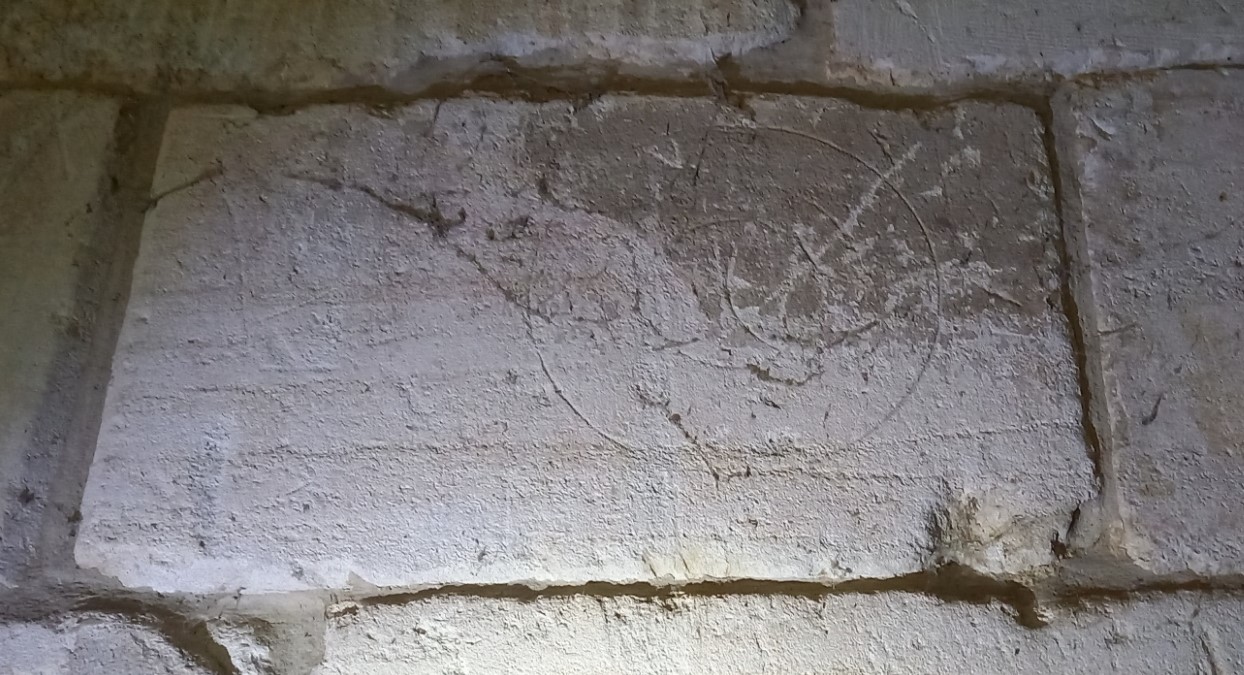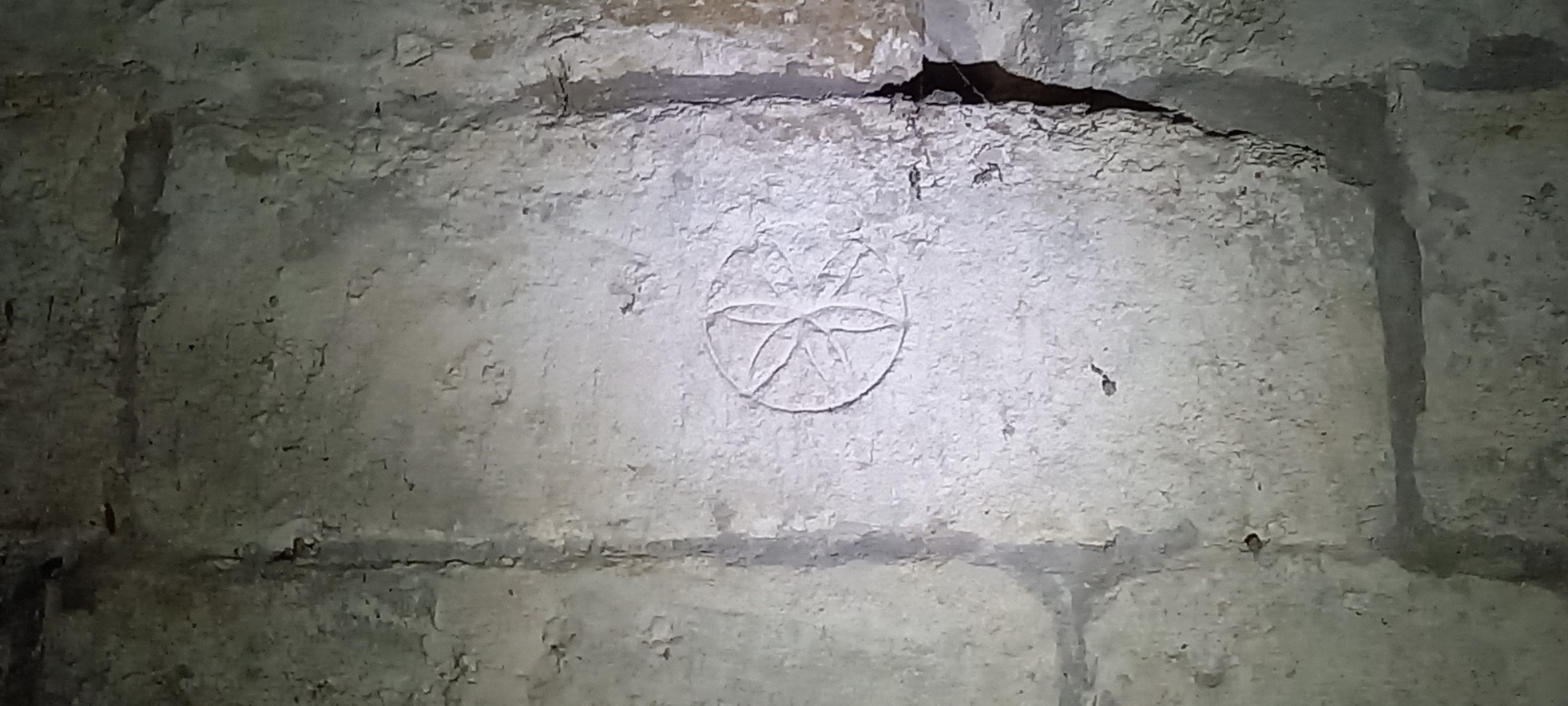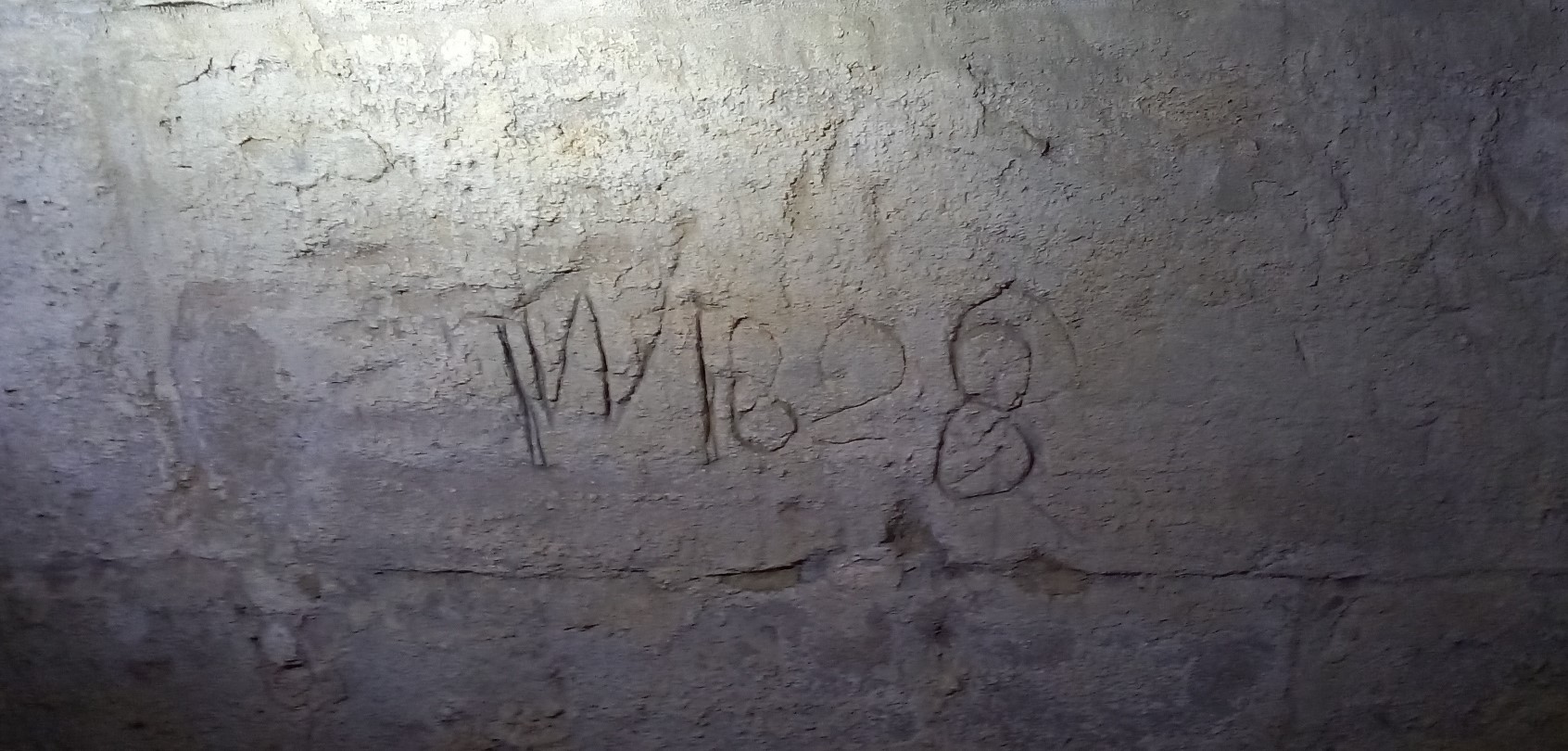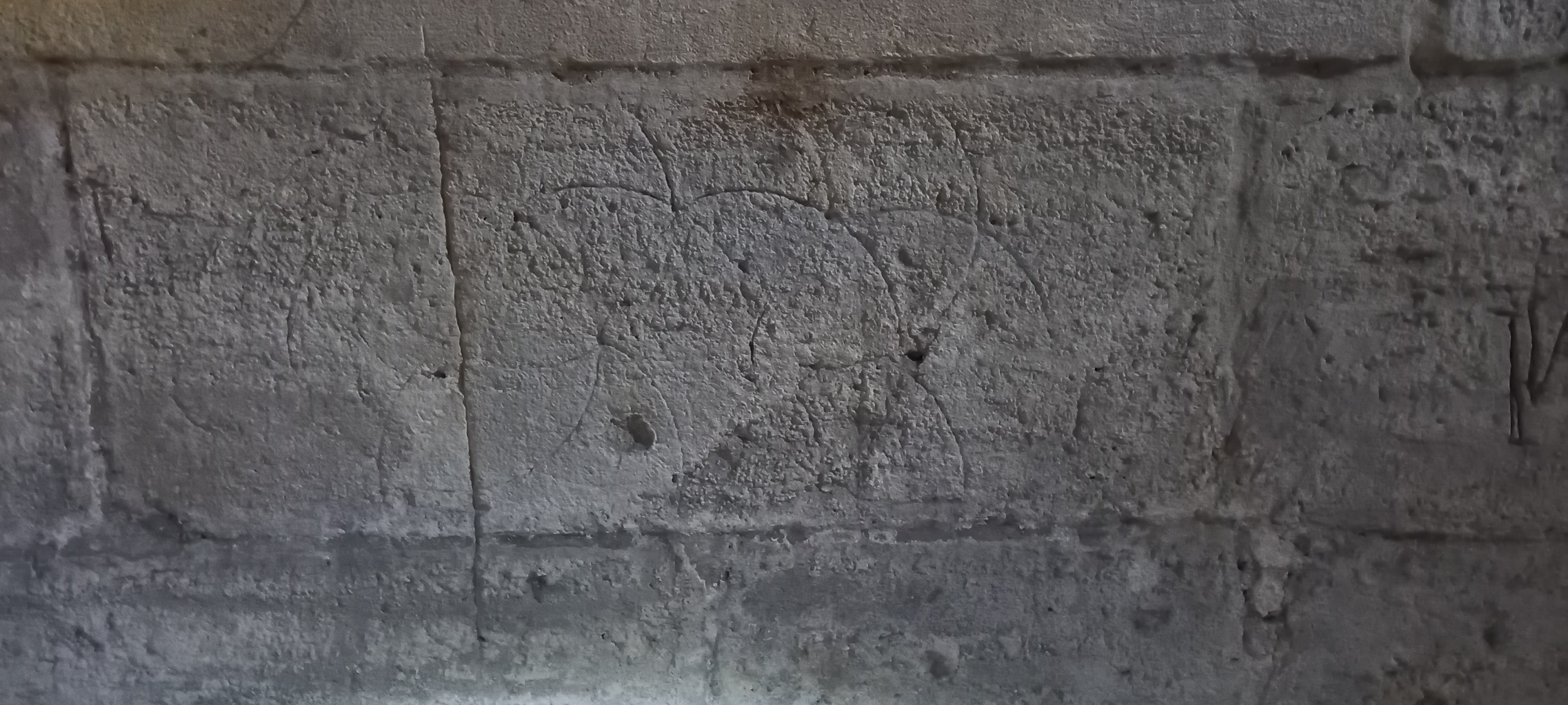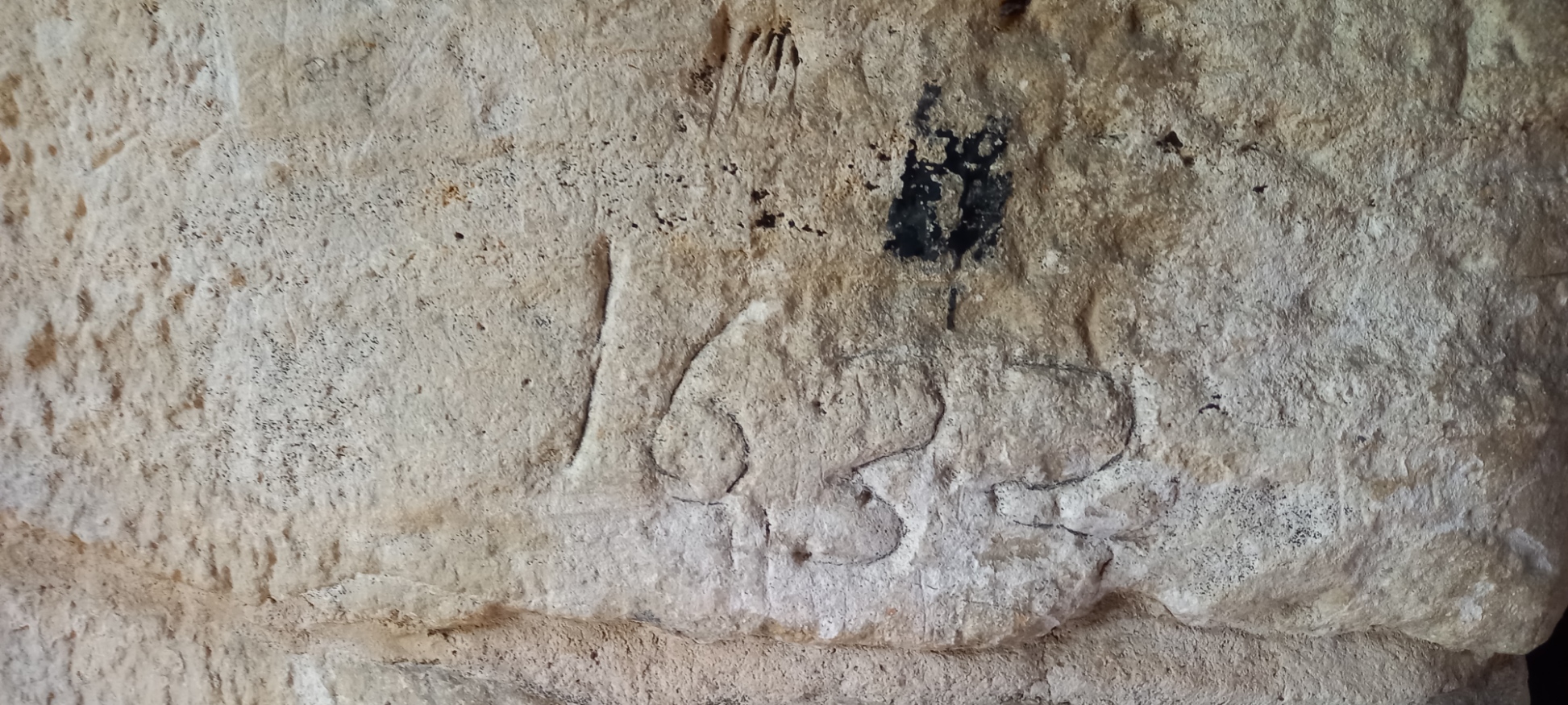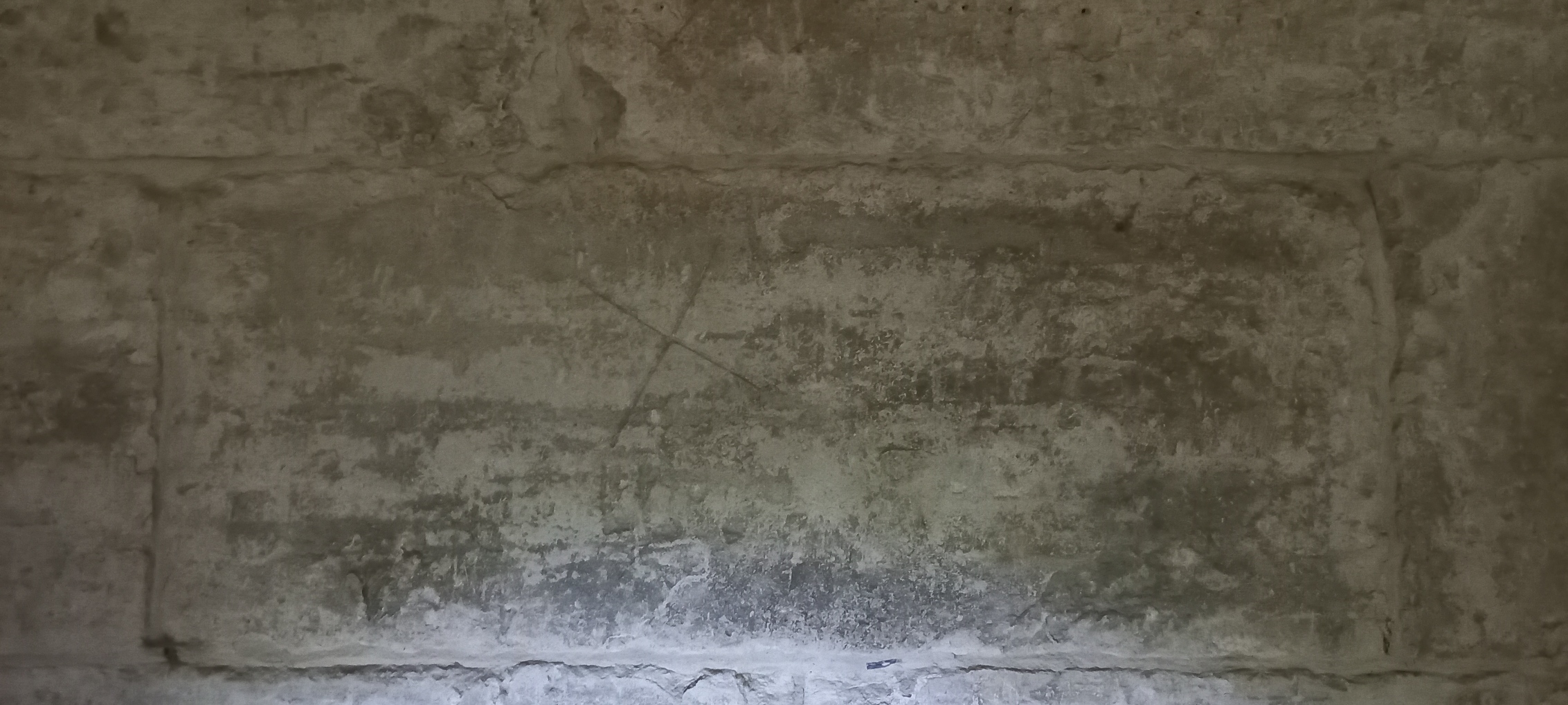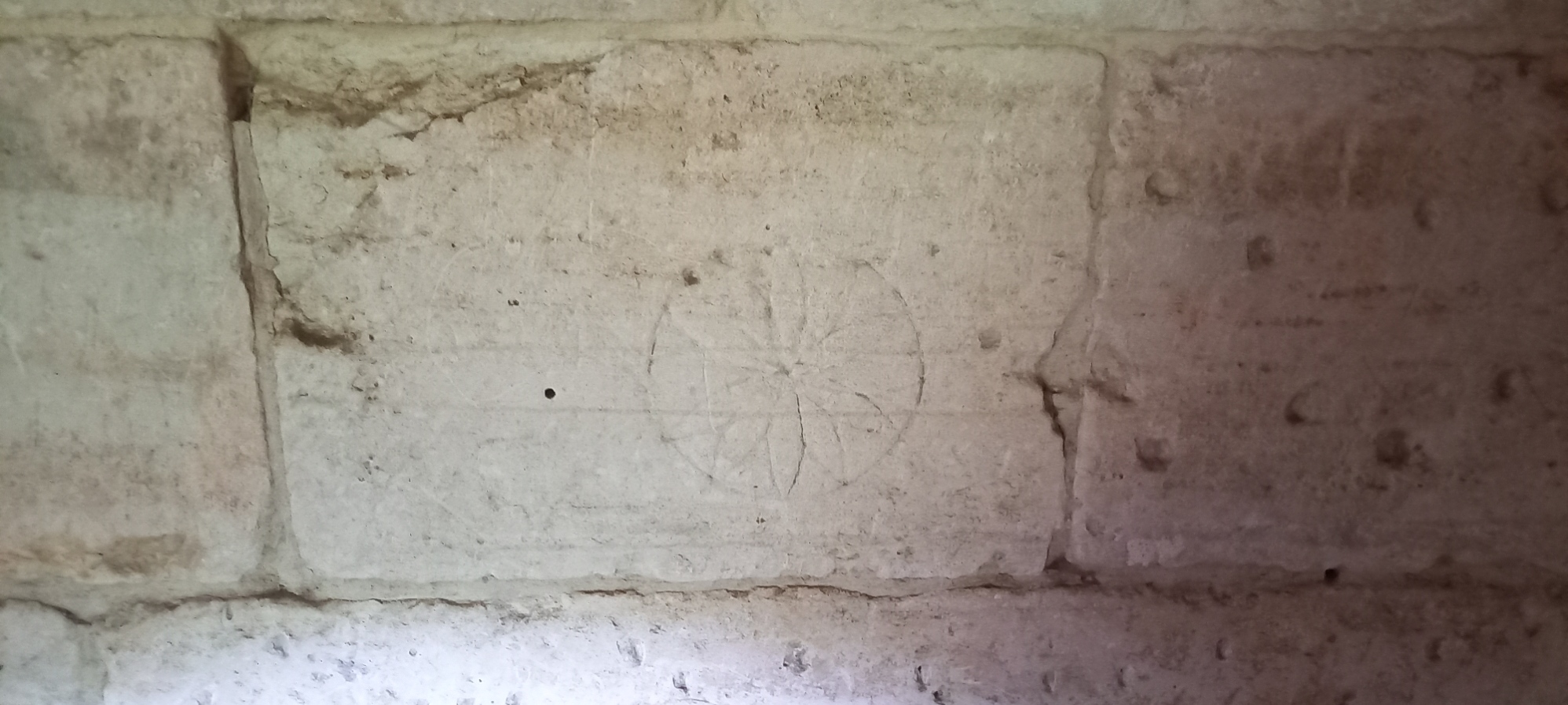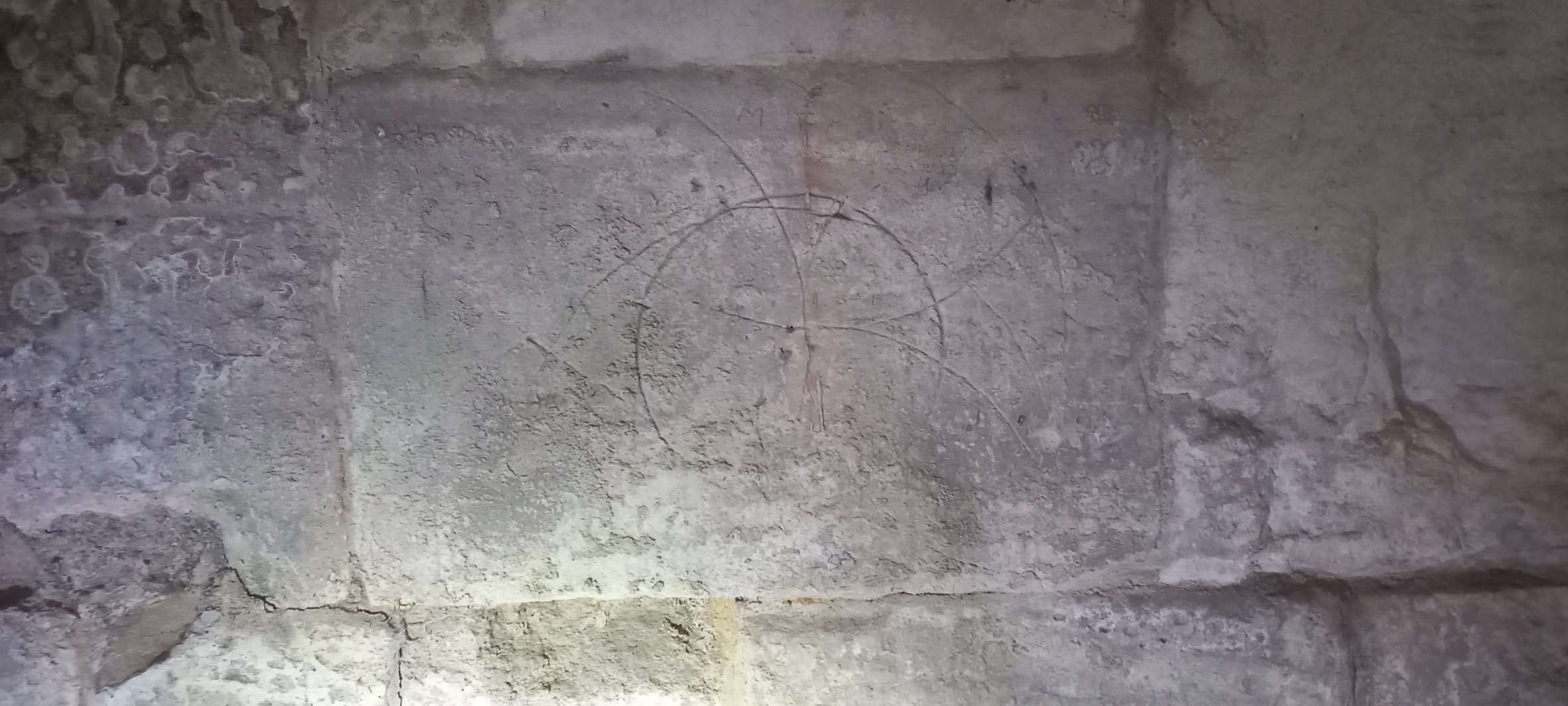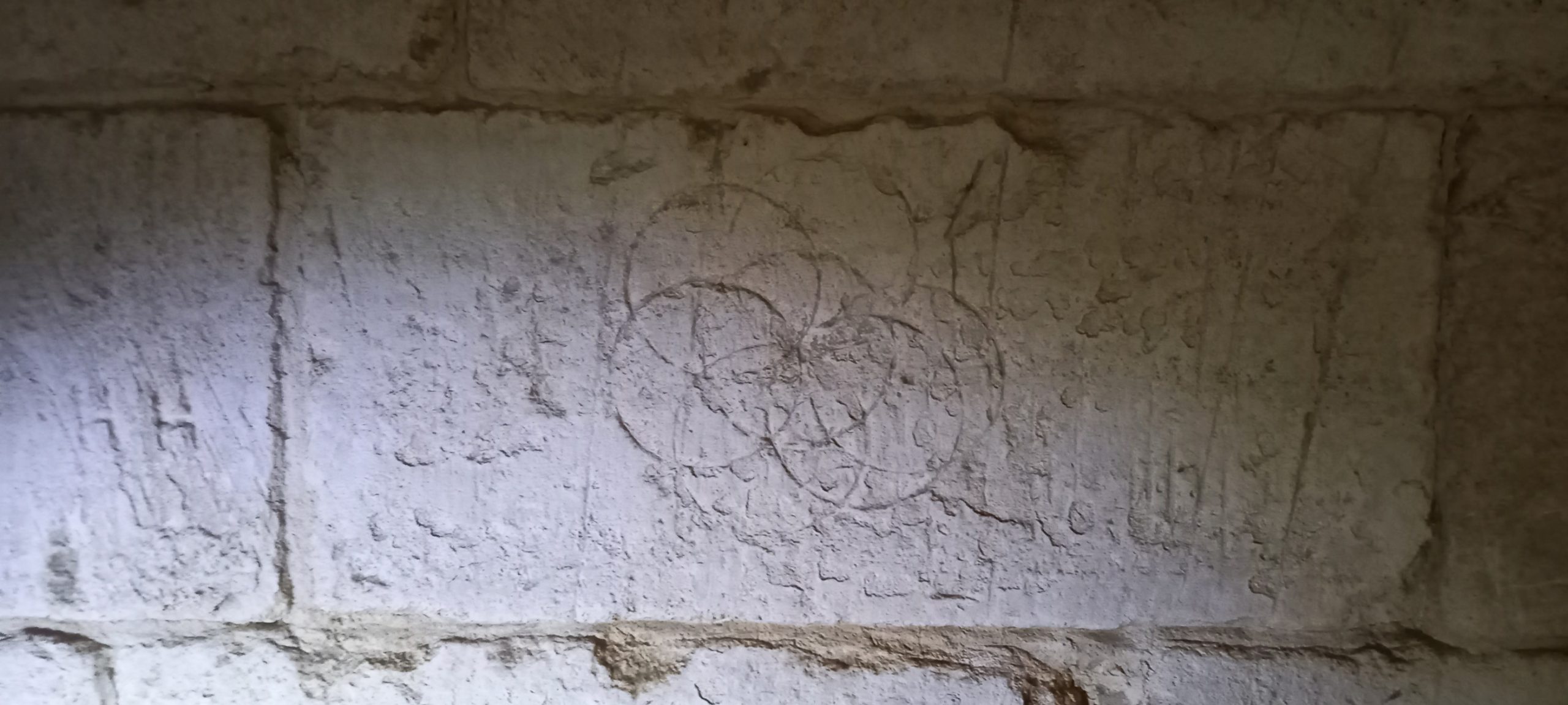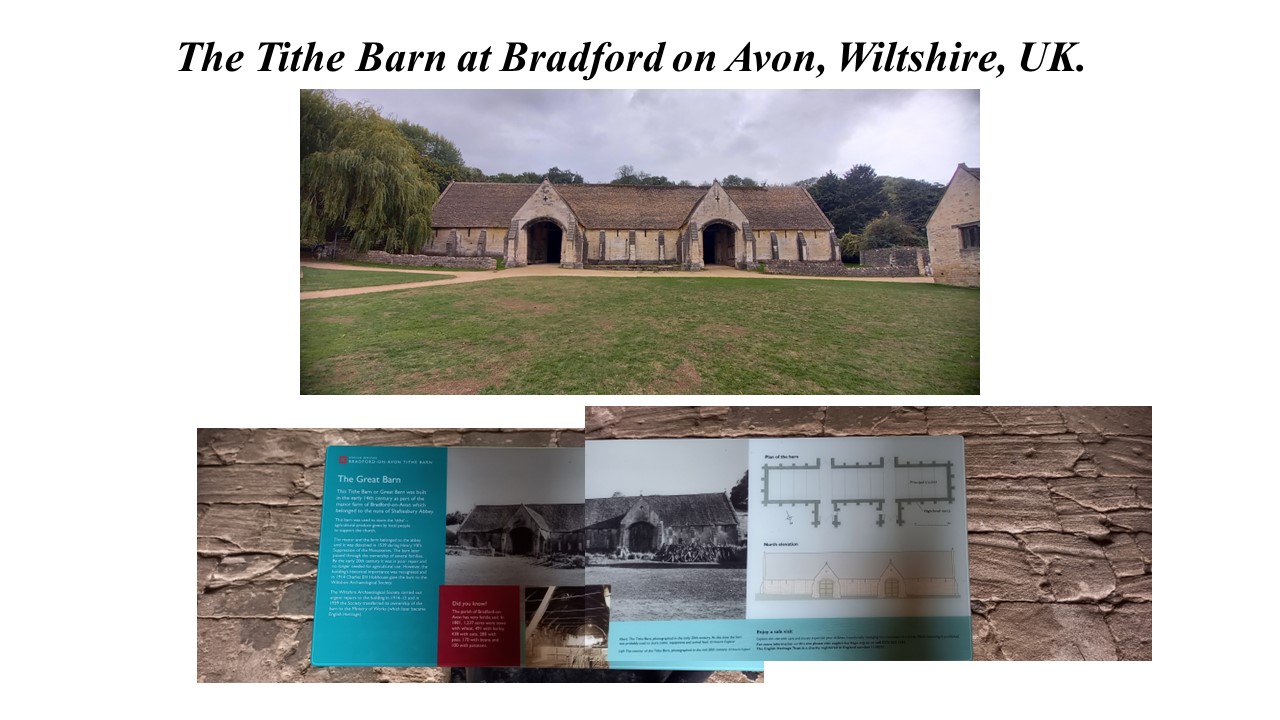
The following historical background and description can be accessed from the English Heritage website at History of Bradford-on-Avon Tithe Barn | English Heritage (english-heritage.org.uk
The images of graffiti and inscriptions were taken by mendipgeoarch on 27th September 2022.
“HISTORY OF BRADFORD-ON-AVON TITHE BARN
Bradford-on-Avon Tithe Barn is one of the largest medieval barns in England, and architecturally one of the finest. It was built in the mid-14th century to serve Barton Grange, a manor farm which belonged to Shaftesbury Abbey in Dorset, the richest nunnery in medieval England. After the abbey was suppressed in 1539, the barn passed into private hands, and was part of a working farm until 1914. See English Heritage plan of the tithe barn
SOME EXAMPLES OF GRAFFITI/INSCRIPTIONS OBSERVED (see also Appendix below)
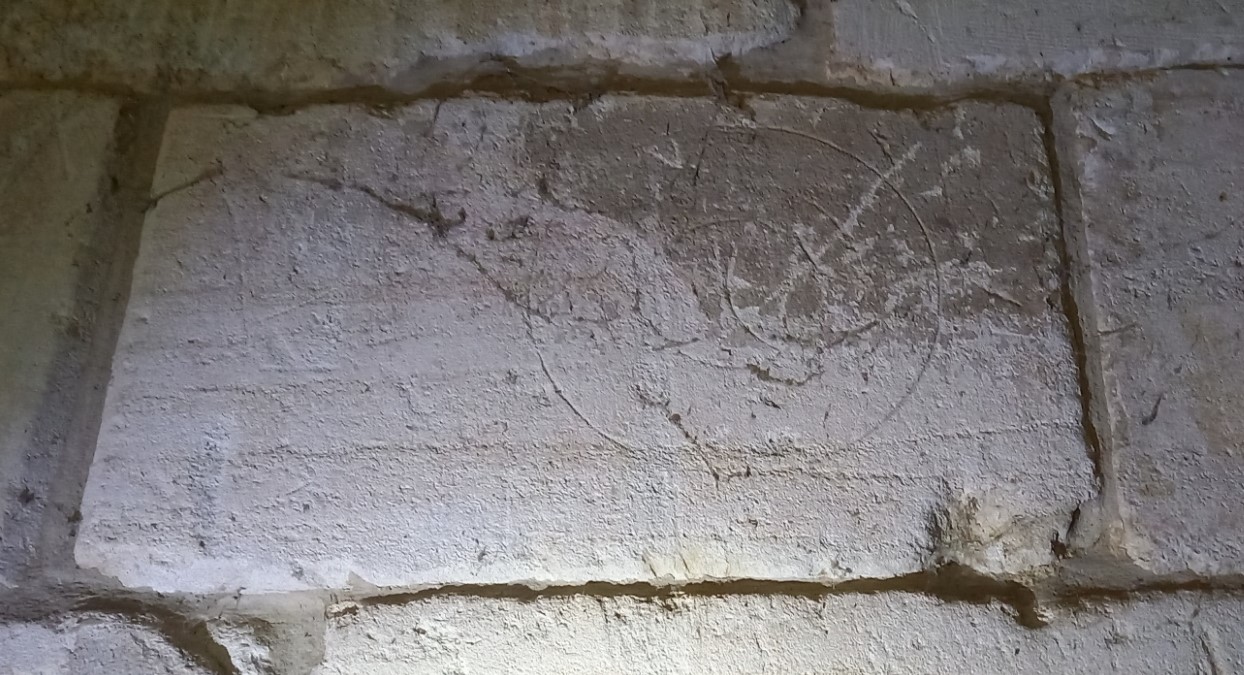
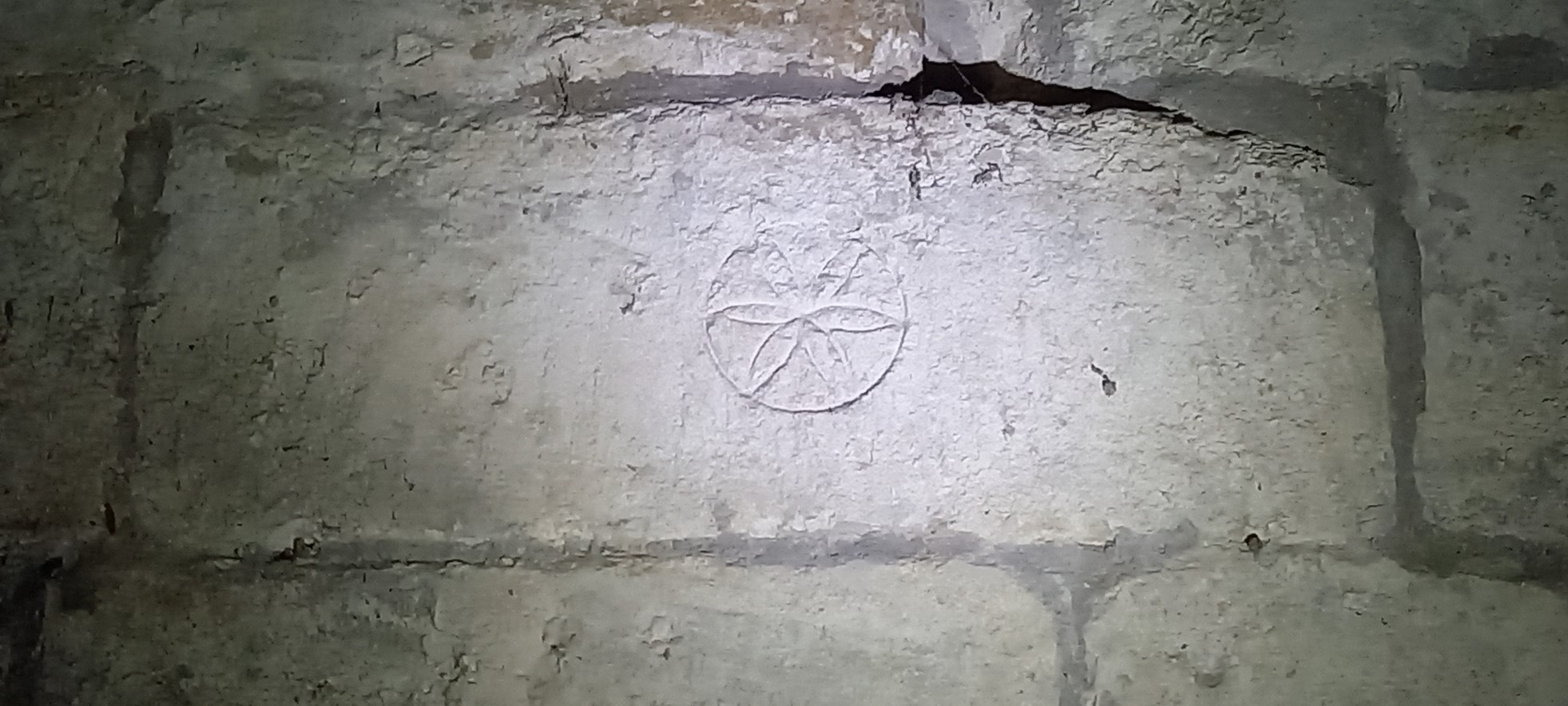
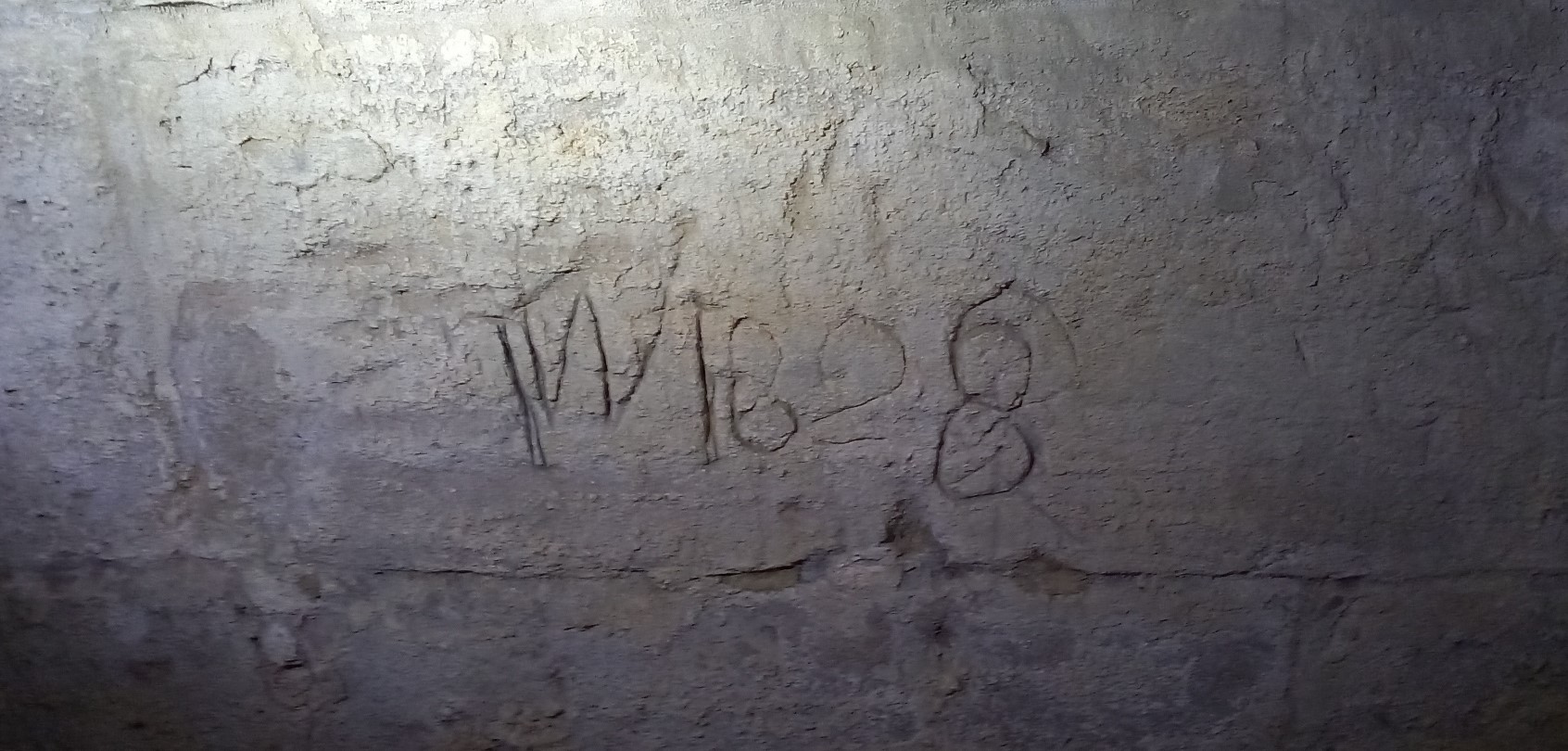
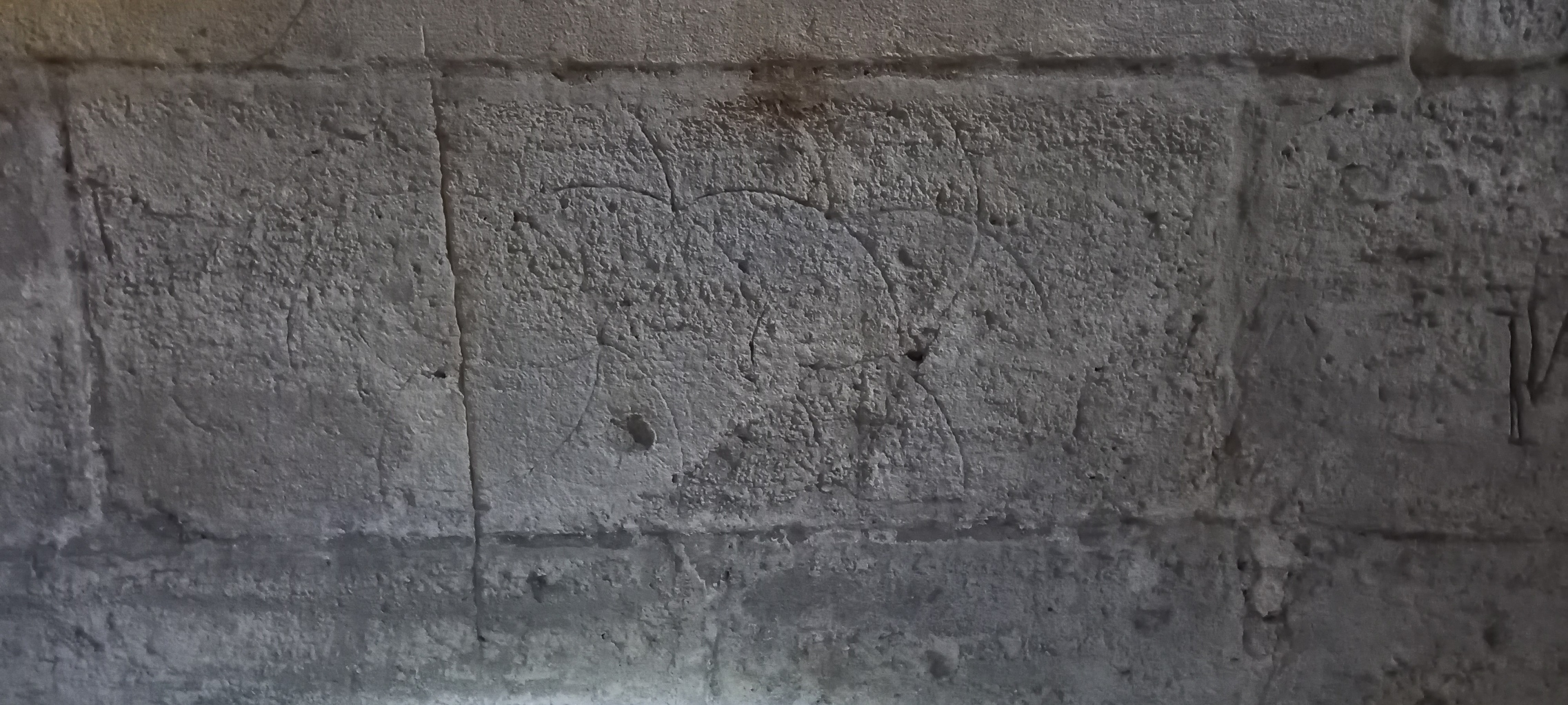
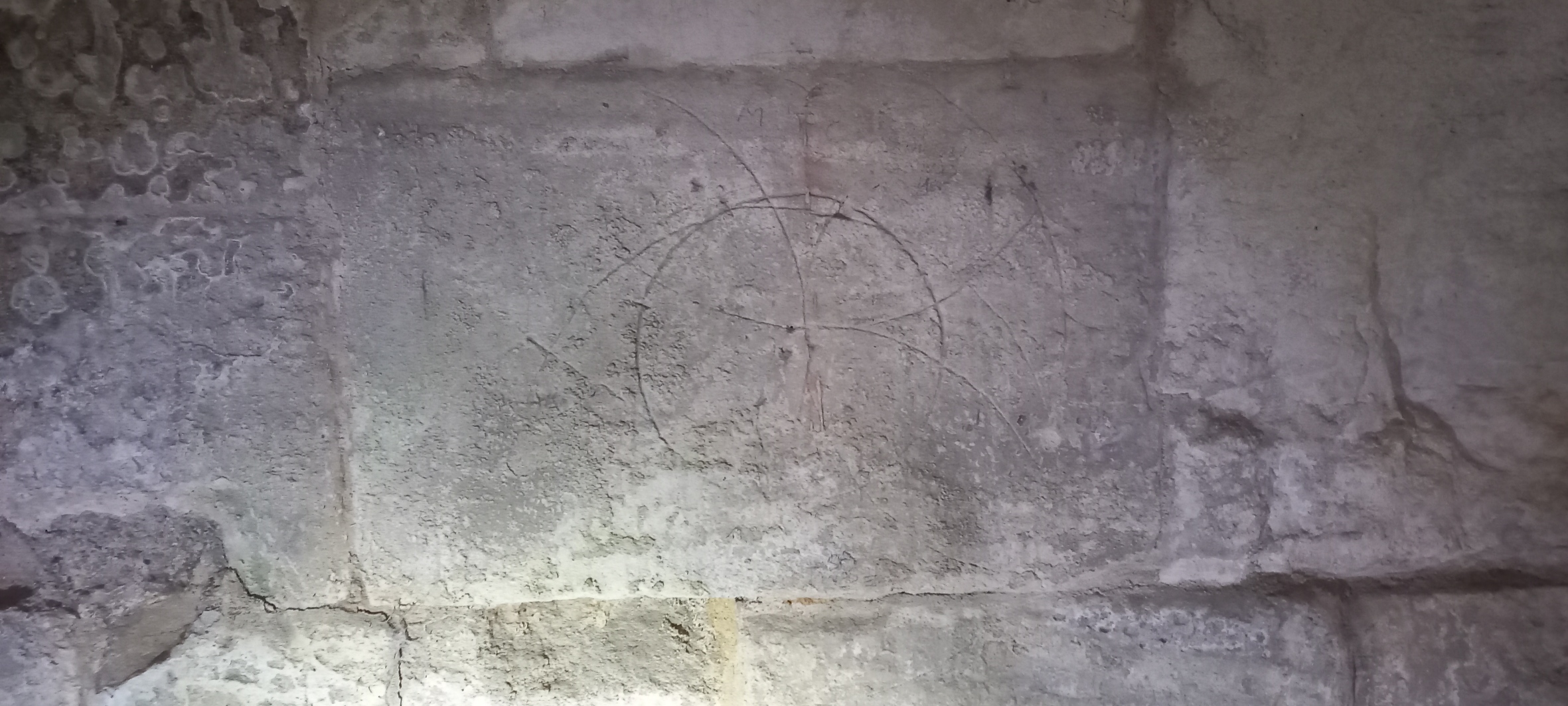
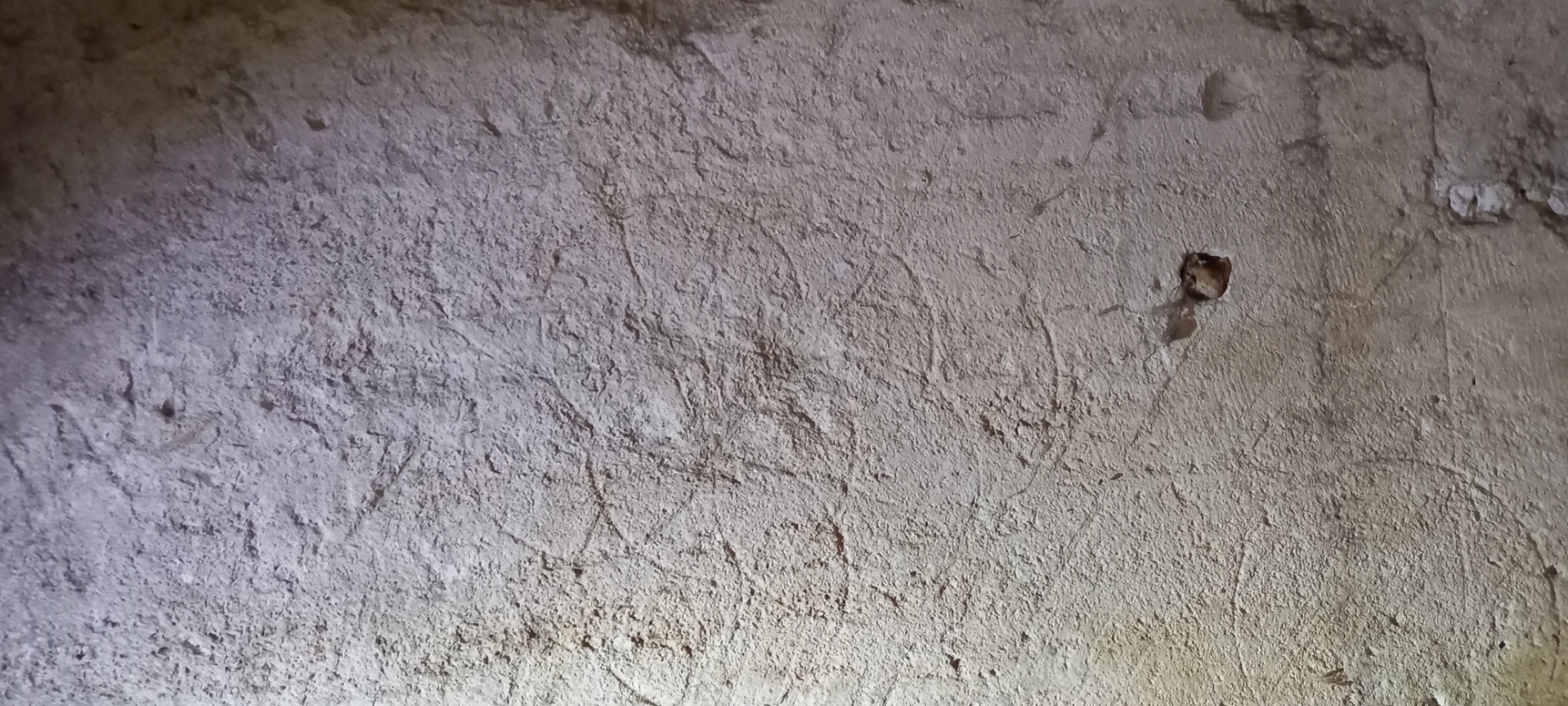
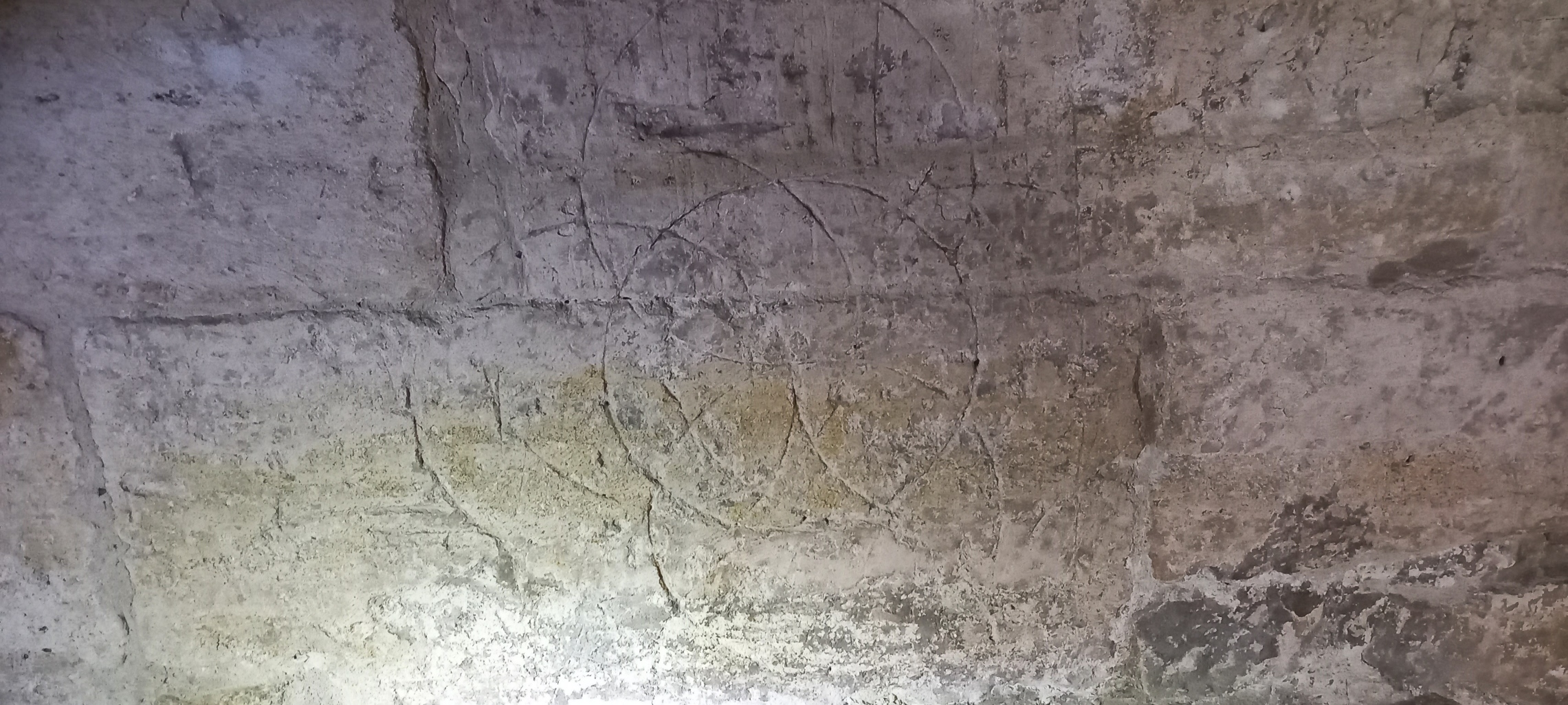
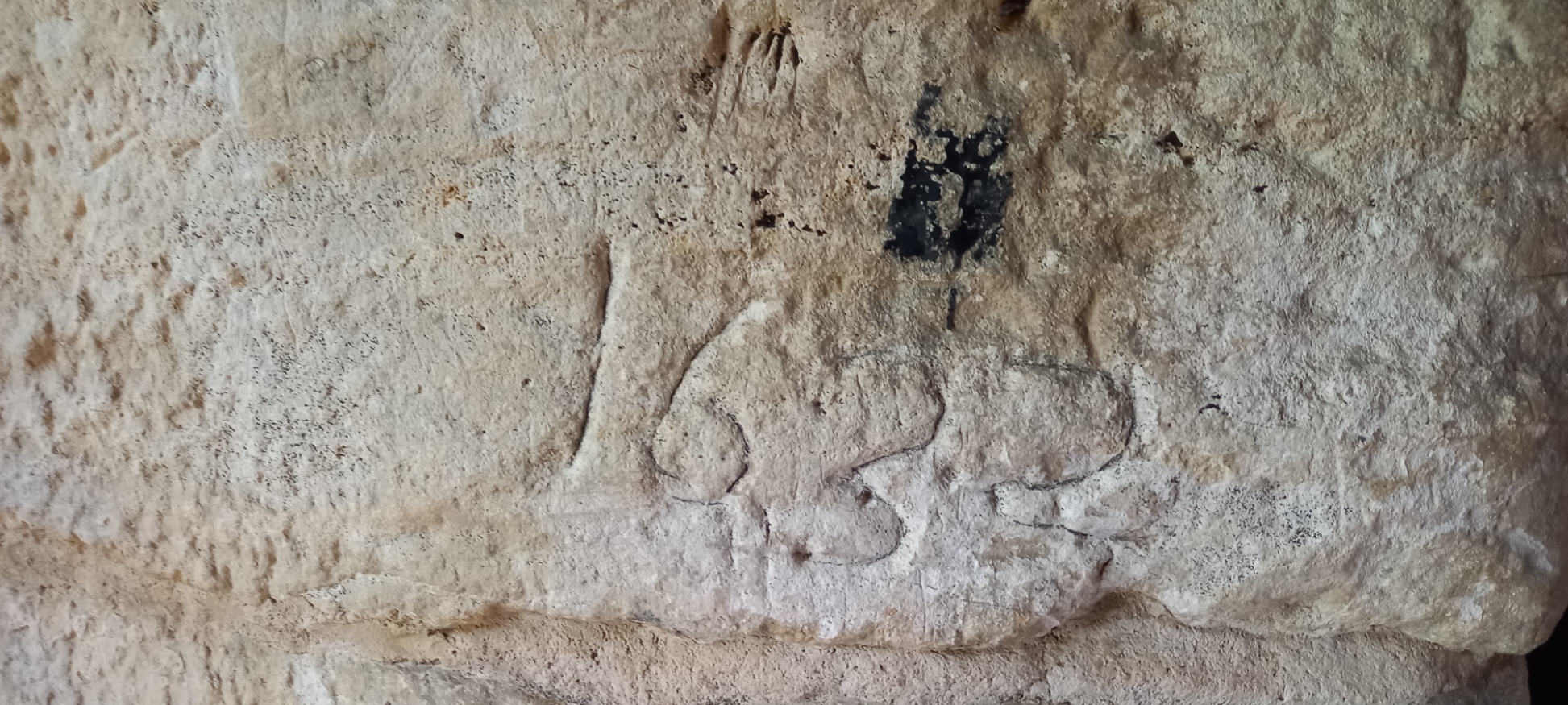
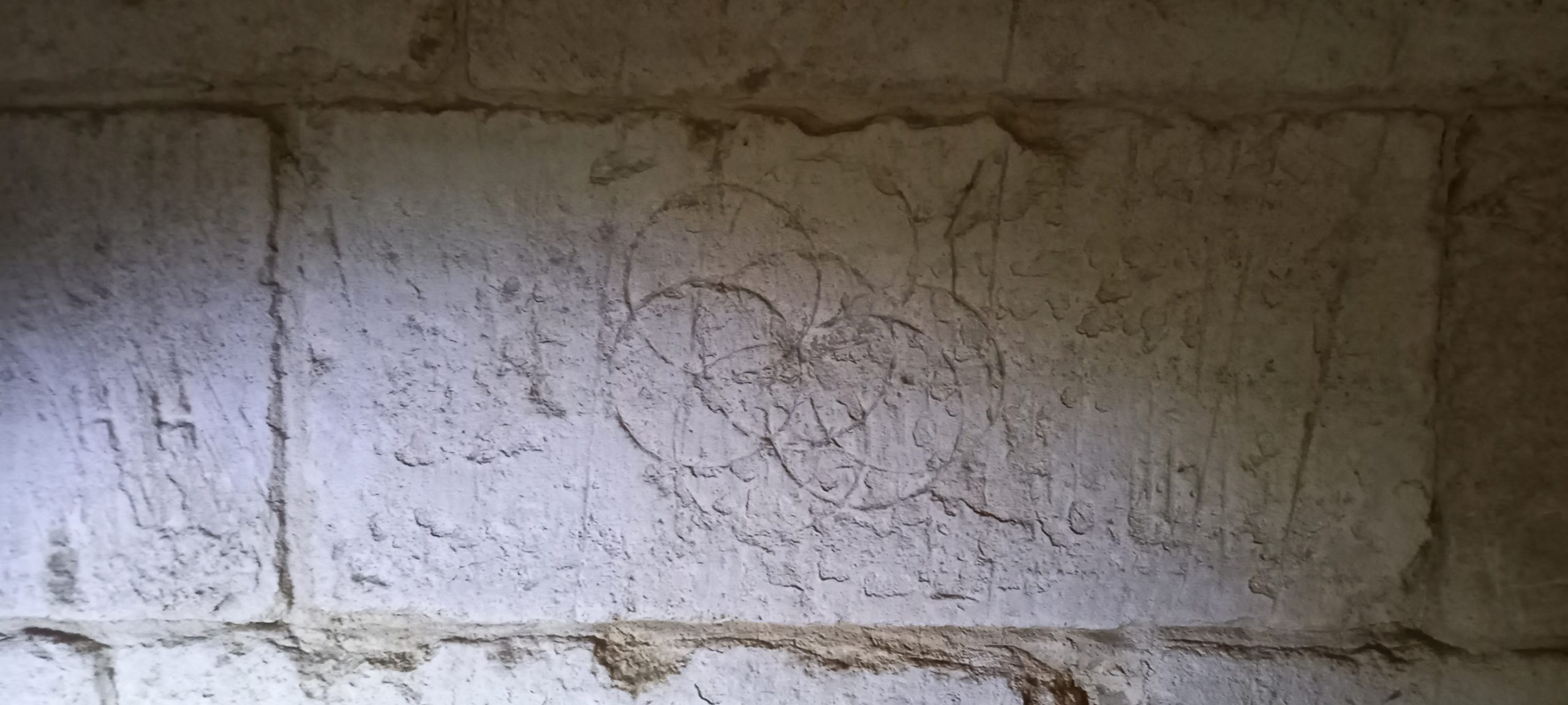
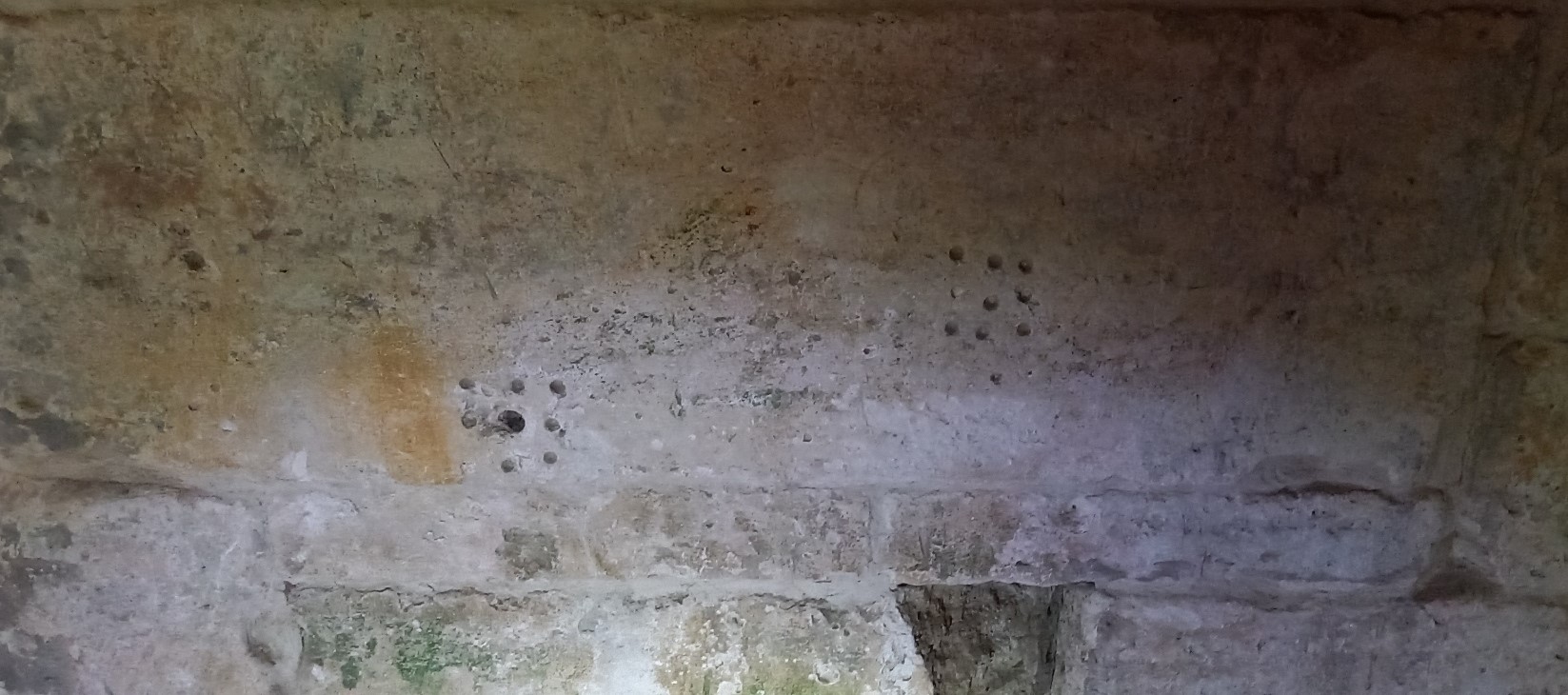
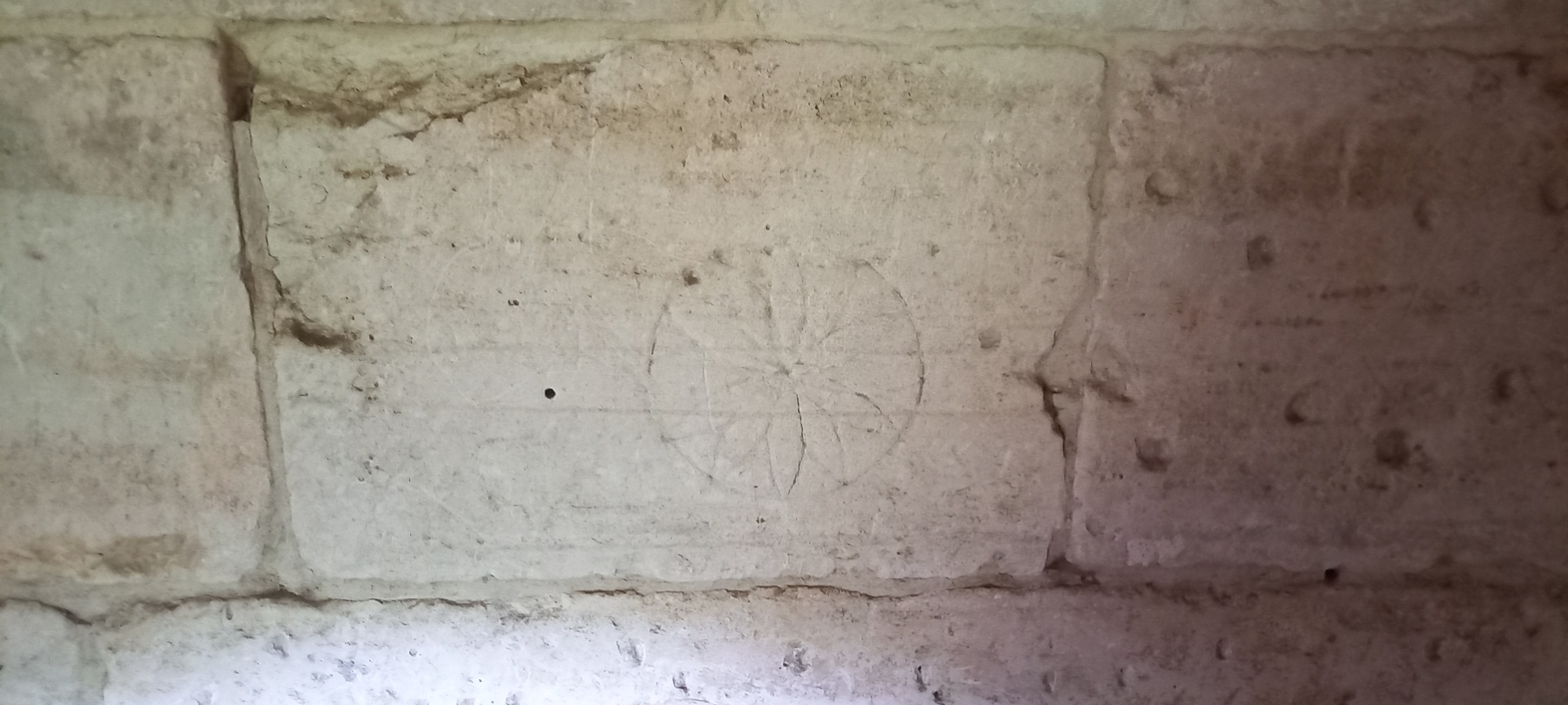
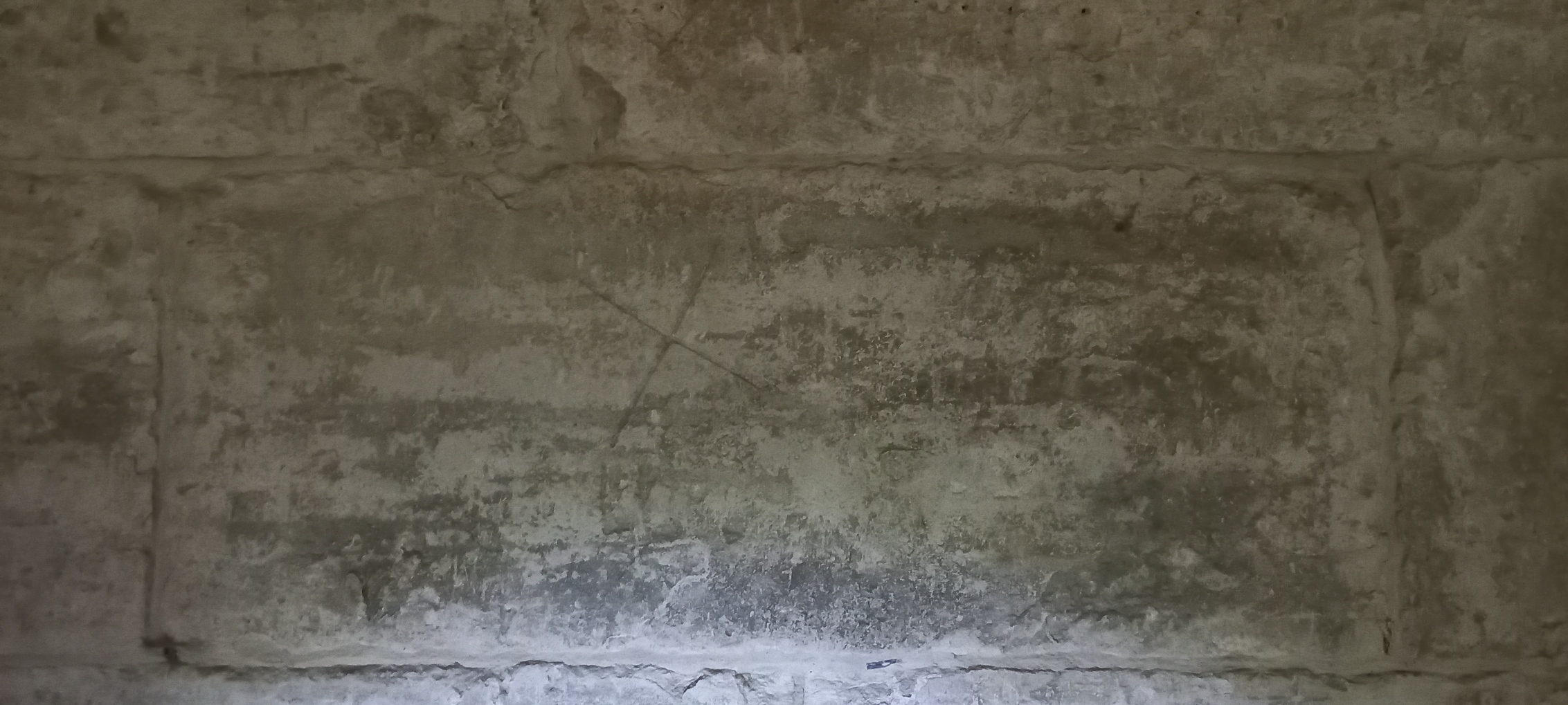
EARLY HISTORY
The name ‘Bradford’ means the ‘broad ford’ on the Avon. The earliest mention of the place is in the Anglo-Saxon Chronicle for AD 652, which refers to King Ceanwalh of Wessex fighting a battle at Bradford on the Avon, but this does not necessarily mean that a settlement existed there.
One had certainly appeared by 1001, when King Æthelred ‘the Unready’ (r.978–1016) granted the manor of Bradford, consisting of lands, the parish minster (religious community) and adjacent town, to the nuns of Shaftesbury Abbey, one of the richest religious houses in England. He made the gift in honour of his half-brother, King Edward ‘the Martyr’, who had been murdered in 978, probably by Æthelred’s mother’s retainers. Æthelred stipulated that Edward’s bones should be enshrined at Bradford, where they might be venerated, although there is no evidence that the martyred king’s remains were ever brought there.
The manor of Bradford-on-Avon was very large. The Domesday Survey of 1086 reckoned it at 42 hides, with an outlying estate of another 7 hides. There was land for 40 ploughs, 8 of which belonged to the manor farm, Barton Grange. The whole manor was worth £60 a year, making it an outstandingly valuable property.
THE TITHE BARN
Barton Grange was a notably large and well-equipped manor farm. It must have had substantial buildings through the 11th, 12th, and 13th centuries, although little archaeological evidence from this early has been found on the site. An early barn, just under 43 metres (140 feet) long, was built probably in about 1300. This would have been dwarfed by the new, great barn.
The great barn has been dated to the 1330s, although there is no known documentary evidence for its building. It was probably built because Shaftesbury Abbey had secured control of the rectory (the parish church and its associated lands) at Bradford-on-Avon in 1332, and thus of its tithes – the tenth part of the property’s agricultural produce to which the rector was entitled. So, although the barn was part of a manor farm, it is probably correct to style it a ‘tithe barn’.
Accounts for five of the years between 1367 and 1392, when Joan Formage was abbess, reveal much about the management of the manor and farm. An inventory for 1367 states that there were 21 keys to the farm as a whole, including two for the ‘great barn’. These were probably for the side entrances into its north porches.
The farm and manor were valuable to Shaftesbury Abbey. A 1535 Crown survey of all monastic properties in England noted that the manor of Bradford-on-Avon produced an annual income of £154 5s 4d.
A lithograph showing the town of Bradford-on-Avon in the mid-19th century, with Barton Farm in the foreground. The newly built Kennet and Avon Canal runs parallel to the tithe barn© Wiltshire and Swindon History Centre
THE SUPPRESSION OF SHAFTESBURY ABBEY
Shaftesbury Abbey was closed as part of the Suppression of the Monasteries in 1539. In 1546, Henry VIII granted Bradford-on-Avon manor to Sir Edward Bellingham, a gentleman of the Privy Council. Upon Bellingham’s death in 1551 it reverted to the Crown.
Over the next 80 years, the manor passed through several hands, although it was never occupied as a principal residence. In 1635 it passed to William Paulet, Marquess of Winchester. The Paulets then held the manor and the barn until 1774, when they sold it to the neighbouring landlord, Paul Methuen of Corsham. In 1850 the manor was bought by Sir John Cam Hobhouse, Baronet, later 1st Lord Broughton. The lordship of the manor has remained in the Hobhouse family ever since.
Throughout these changes of ownership, Barton Farm continued to be a large working manor farm, occupied by tenant farmers. It is unclear how the barn itself was used. It did not have any suitable defences against vermin, so it may be have been used for cattle, or their fodder, or to store equipment, rather than for storing crops.
END OF USE
By 1914, the barn was no longer required for the manor farm. However, its outstanding historic and architectural value began to be recognised. Reginald Hobhouse, as agent for his father, Sir Charles Hobhouse, Baronet, wrote to Alfred Burder, a local antiquary, to inform him that:
The Barn at Barton Farm was no longer required for the use of the farm, and that Sir Charles was not prepared to spend the necessary money to put it in repair but was willing to hand it over to any Society that was willing to do so; failing this, the only alternative would be to demolish it, which it would seem a pity to do.
Burder wrote to Charles Peers, Principal Inspector of Ancient Monuments for the Office of Works, who sent a surveyor down to inspect the barn. Peers said that if costs were met for immediate repairs to be carried out, the Office of Works might be willing to take responsibility for the building. This initiative was overtaken by the outbreak of war in 1914.
The Wiltshire Archaeological Society then came to the rescue, and agreed to take responsibility for the building, which Sir Charles transferred to them in the same year.
REPAIR AND CONSERVATION
The Wiltshire Archaeological Society commissioned the eminent conservation architect Harold Brakspear to survey the barn. He noted that the original design of the building, which did not include any adequate tying-in of the roof trusses, had caused the walls to spread outwards over a long period. The barn’s owners had made many attempts to address this in the past, adding struts and ties, and extra buttresses. Nevertheless, Brakspear concluded that:
the building is anything but secure, and the tiling is in a deplorable state, and lets in the weather, which, in a short time, will rot all the timbers. Besides the faulty construction of the roof, a most alarming defect occurs in the condition of the couples themselves. These have a considerable amount of their lower parts embedded in the walls, where they rest on templates, and it seems that the whole of this portion of the walls is quite rotten, so that these heavy couples … may collapse at any moment.
The Society launched a successful appeal in Wiltshire and beyond for funds. The repairs, which included the replacement of a good deal of decayed timber, were carried out between 1914 and 1915.
Financial constraints led the Society to transfer ownership of the barn to the Ministry of Works in 1939, and the Ministry carried out major repairs in the 1950s.
REFERENCES
RB Pugh and E Crittal (eds), The Victoria County History of Wiltshire, vol 7 (London, 1953), 12 (accessed 13 Nov 2015)
J Morris (ed), Domesday Book, Wiltshire (Chichester, 1979), 39; Pugh and Crittal, op cit, 12–13
J Haslam, ‘Excavations at Barton Farm, Bradford-on-Avon, 1983: interim report’, Wiltshire Archaeological and Natural History Magazine, 78 (1984), 120–21; M Heaton and W Moffatt, ‘Recent work at Barton Grange farm, Bradford-on-Avon’, Wiltshire Archaeological and Natural History Society Magazine, 97 (2004), 211–17 (accessed 13 Nov 2015)
B Harvey and R Harvey, ‘Bradford-on-Avon in the 14th century’, Wiltshire Archaeological and Natural History Magazine, 86 (1993), 118–29 (accessed 13 Nov 2015)
J Caley and J Hunter (eds), Valor Ecclesiasticus Temp. Henry VIII. Auctoritate Regia Institutus, vol 1 (London, 1810), 278
AWN Burder, ‘The mediaeval tithe barn, Bradford-on-Avon: report on the work of repair’, Wiltshire Archaeological and Natural History Magazine, 39 (1915–17), 485–90 (accessed 13 Nov 2015)”
History of Bradford-on-Avon Tithe Barn | English Heritage (english-heritage.org.uk) Accessed 28 September 2022
APPENDIX
